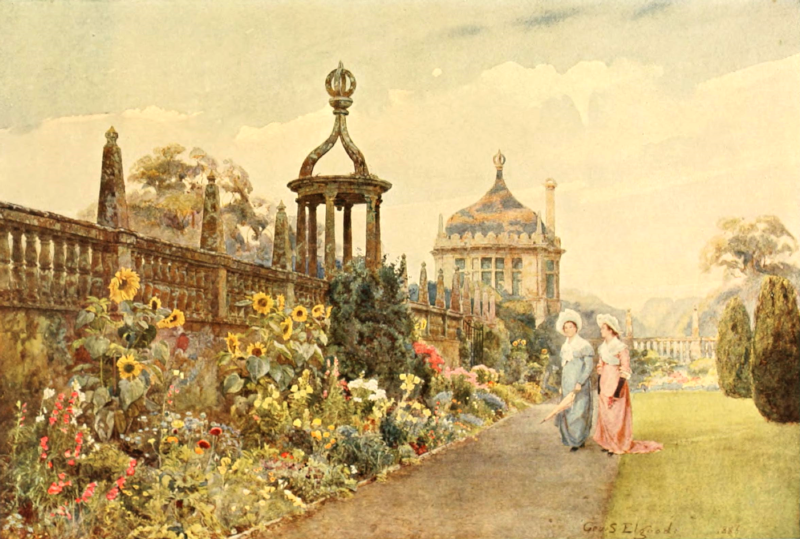| Web
and Book design,
Copyright, Kellscraft Studio 1999-2021 (Return to Web Text-ures) |
 (HOME)
|
|
MONTACUTE MONTACUTE
in Somersetshire, built towards the end of the sixteenth century by Sir Edward
Phelips, is another of that surprising number of important houses built on a
symmetrical plan that arose during the reign of Queen Elizabeth. As
the house was then, so we see it now; unaltered, and only mellowed by time. The
gardens, too, are of the original design, including a considerable amount of
architectural stonework. The
large entrance forecourt is inclosed by a high balustraded wall, with important
and finely-designed garden houses on its outer angles. The length of the side
walls is broken midway on each side by a small circular pillared pavilion with
a boldly projecting entablature, crowned with an openwork canopy and a topmost
ornament of two opposite and joining rings of stone. The piers
of the balustrade are surmounted by stone obelisks, and the large paved
landing, forming a shallow court at the top of the flight of steps a hundred
feet wide, that gives access to the house on this side has tall pillars that
now carry lamps, though they appear to have been designed merely as a stately
form of ornament. The
forecourt has a wide expanse of gravel with a large fountain basin in the
middle. Next the wall there are flower-borders; then the wide gravelled path,
and, following this, a broad strip of turf with Irish yews at regular
intervals. The general severity of the planning is pleasantly relieved by the
bright flower-border, the subject of the picture. To right and left are
openings in the wall leading to other garden spaces. The one of these to the
left, just behind the spectator as in the picture, leads by an upward flight of
steps to one side or a wide terrace walk, that encompasses on all four sides a
large sunk garden of formal design. This garden runs the whole length of the
forecourt and depth of the house, and has a width equal to some two-thirds of
its length. A large middle fountain-basin, with shaped outline of angles and
segments of circles, has a balustraded kerb with a stone obelisk on every pier.
In the centre is a handsome tazza in which the water plays. Wide paths lead
down flights of balustraded steps from all four sides to the gravelled area
within which the fountain stands. The spaces between, and the banks rising to
the level of the upper terraces, are of turf. Rows of Irish yews stand ranged on
both levels. It is all extremely correct, stately — dare one say a trifle dull?
Opposite the forecourt the garden is bounded by a good yew hedge protecting it
from wind from the valley below. Midway in the length is an opening where a low
wall and seats give a welcome outlook. The same yew hedge returns eastward to
the south-east angle of the house; the garden's opposite boundary being a low
wall with a sunk fence outside, giving a view into the park. There
is an entrance from the garden to the house on its southern side by a flight of
balustraded steps, and niches with seats are on either side of the door. Wonderful
are these great stone houses of the early English Renaissance — wonderful in
their bold grasp and sudden assertion of the new possibilities of domestic
architecture! For it may be repeated that it was only of late that a man's
house had ceased to be a place of defence, and that he might venture to have
windows looking abroad all round, and yet feel perfectly safe without even an
inclosing moat. In
the present day it is somewhat difficult to account tor the designer's attitude
of mind when deciding on such a lavish employment of the obelisk-shaped
finials. One can only regard it as the outcome of the taste or fashion of the
day, when he borrowed straight from the Italians everything except their
marvellous discernment. One accepts the many obelisks at Montacute as showing
the reflection of Italian influence on the Tudor mind; to-day and new, they would
be inadmissible. The modern mind, with the vast quantity of material at hand,
and the easy access to all that has been said and done on the subject, should accept
nothing but the best and purest in this as in any other branch of fine art. There
is one other possible way of accounting for the prevalence of these
all-pervading obelisks. The name of the place is taken from a conical wooded
hill (mons acutus). The same play on a word, a favourite fashion of Elizabethan
times, and a custom in heraldry from a remoter antiquity, is seen in the shield
of the ancient Montacute family, where the three sharp peaks denote that the
surname had the same origin. The connexion of this name with the acute peak or
obelisk form would therefore the more readily commend itself to the Elizabethan
mind. The
house has never gone into other hands, the present owner, Mr. W. R. Phelips,
being the descendant of the founder.  From the picture in the possession of Mr. K. C. Austen Leigh |